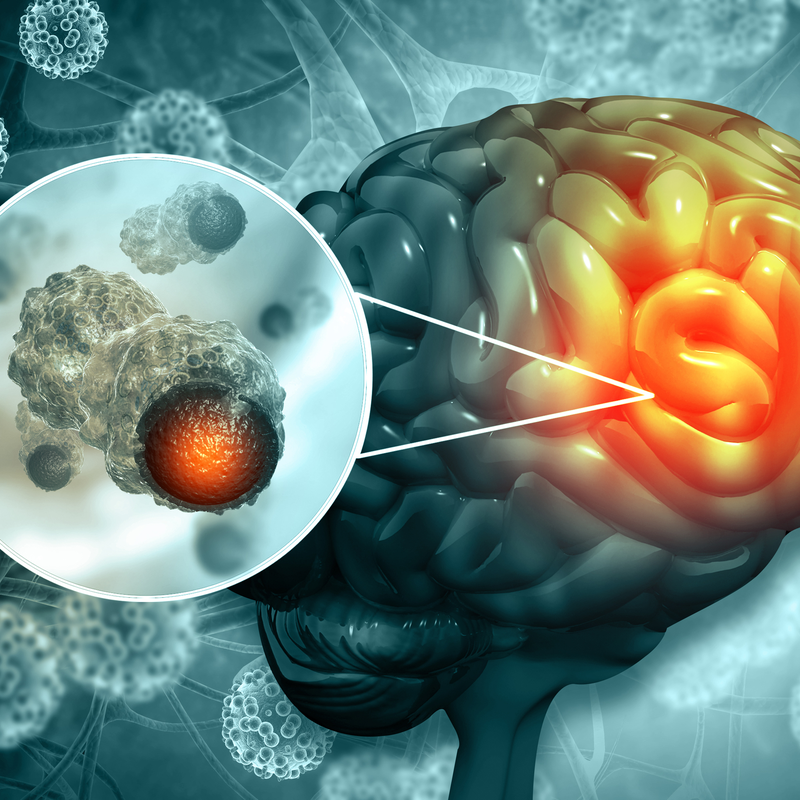
What are malignant meningiomas?
A malignant meningioma refers to a malignant brain tumour that occurs rather rarely and accounts for only 2 to 3 percent of all menigeomas. Malignant meningiomas form from the meninges, with men developing this disease more often than women. Malignant brain tumours quickly become larger and can grow into the surrounding brain structures or, through the metastasis of daughter tumours (metastases), into another tissue . The prognosis for a malignant meningioma is rather unfavourable and makes postoperative radiotherapy necessary in any case.
What is the severity of a malignant meningioma?
The World Health Organisation (WHO) distinguishes between three tumour grades, whereby the first two grades describe a benign brain tumour. A malignant meningioma manifests itself in the third and most serious tumour grade:
- WHO grade III: anaplastic meningioma is the rarest form of all meningiomas and accounts for only about 2 percent of all cases. An analplastic meningioma can metastasise and thus spread to other organ structures.
Also
Meningiomas of the second WHO grade are in some cases not only
difficult to treat, but can even become malignant. An operation
can be more difficult here than with meningiomas of the
first WHO grade.
What causes a malignant meningioma to form?
Like other cancers, malignant meningiomas are caused by the degeneration of a certain type of cell. Although the exact cause of this mutation is still unclear to medical experts, they assume, especially in the formation of a malignant meningioma, that children who have received radiation therapy due to cancer, but also atomic bomb survivors have a greater risk of developing a malignant brain tumour (an anaplastic meningioma).
What are the symptoms of a malignant meningioma?
A malignant meningioma can cause seizures due to its rapid growth. However, particularly large tumours can also cause the following neurological disorders:
- Speech disorders,
- Paralysis,
- Visual disturbances,
- Deterioration of the sense of smell,
- in some cases, personality changes can even occur.
Depending on
where the meningioma occurs, it can also impair the drainage of
cerebrospinal fluid. This can lead to a condition called
hydrocephalus. Headaches are also a common
side effect of meningioma, but in the
rarest cases they are caused directly by the tumour.
How is a meningioma diagnosed?
Due to the fact that a malignant meningioma usually already causes symptoms , the diagnosis at this stage is usually no longer an incidental finding. The patient presents to the doctor because of the symptoms, whereupon a magnetic resonance tomography (MRT) or a computer tomography (CT) is carried out. Using a contrast agent , abnormalities can be made visible. Both an MRI and a CT scan can show the exact position and size of the tumour. An additional X-ray examination of the blood vessels of the head (angiography) can also determine which vessels are connected to the tumour, or whether certain vessels have been displaced by the tumour and thus restrict the blood flow .
How is a malignant meningioma treated?
Malignant meningiomas usually grow continuously and compress the brain because of their size. For this reason, they usually cause symptoms and should be treated urgently. Surgical removal of the tumour is the standard treatment for these cases. However, since this is not always possible due to the location and size of the tumour , radiosurgical therapy is also an option. The respective treatment therefore depends on the location of the tumour, but also its size and speed of growth. In addition, there are many other factors, such as the patient's general state of health.
In an operation, the meningioma is reduced in size from the inside out. In this way, the borders to the neighbouring tissue are to be relieved. Surgically, the tumour-bearing meninges are removed and replaced. The process of meninges replacement can vary in intensity from patient to patient . This depends on whether the tumour has a smooth border or has already infiltrated the brain surface . The intervention becomes particularly difficult if the tumour is already supplied with blood by normal brain vessels. Thanks to the latest technical procedures, such as augmented reality, the so-called neuronavigation or intraoperative neuromonitoring, it is possible for the neurosurgeon to look into the tissue with maximum precision and to perform the intervention under the greatest safety precautions.
All meningiomas are sensitive to radiation. For a meningioma that cannot be operated on, radiation therapy is therefore usually performed. However, the tumour must not have exceeded a certain size for radiotherapy. If neither surgery nor radiotherapy is an option, radionuclide therapy is an alternative. This is mainly used in difficult cases with progressive progression of the disease. In radionuclide therapy , the tumour is specifically attacked with radioactive drugs. The so-called radiopharmaceutical is often used here. It is a radioactive substance that binds special receptors (somatostatin receptors) on the tumour surface, achieves a local radiation effect here and destroys the tumour cells.
In general, it can be stated with regard to the treatment of a malignant meningioma that a complete removal of the tumour is almost impossible from the second WHO grade. Depending on where the meningioma is located, it can affect important structures. This is the case, for example, if the meningioma is located near the pituitary gland or the brain stem. This is where not only the aorta is located, which is responsible for the blood supply to the brain, but also the and the pituitary gland.
What is the prognosis for a malignant meningioma?
The chances of a complete cure for a malignant meningioma of the third degree of severity are rather unfavourable. This is mainly because the brain tumour can metastasise.
